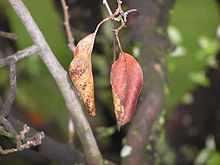Wilting
From Wikipedia, the free encyclopedia

Wilted fig leaves on a branch
Wilting refers to the loss of rigidity of non-woody parts of plants. This occurs when the turgor pressure in non-lignified plant cells falls towards zero, as a result of diminished water in the cells. The process of wilting modifies the leaf angle distribution of the plant (or canopy) towards more erectophile conditions.
Lower water availability may result from:
- drought conditions, where the soil moisture drops below conditions most favorable for plant functioning;
- the temperature falls to the point where the plants vascular system can not function.
- high salinity, which causes water to diffuse from the plant cells and induce shrinkage;
- saturated soil conditions, where roots are unable to obtain sufficient oxygen for cellular respiration, and so are unable to transport water into the plant; or
- bacteria or fungi that clog the plant's vascular system.
- water drowns the plant
Wilting diminishes the plant's ability to transpire and grow. Permanent wilting leads to plant death. Symptoms of wilting and blights resemble one another.
In woody plants, reduced water availability leads to cavitation of the xylem.
Wilting occurs in plants such as Balsam and tulasi/tulsi. Wilting is an effect of the plant growth inhibiting hormone, abscisic acid.
This article is issued from Wikipedia. The text is available under the Creative Commons Attribution/Share Alike; additional terms may apply for the media files.